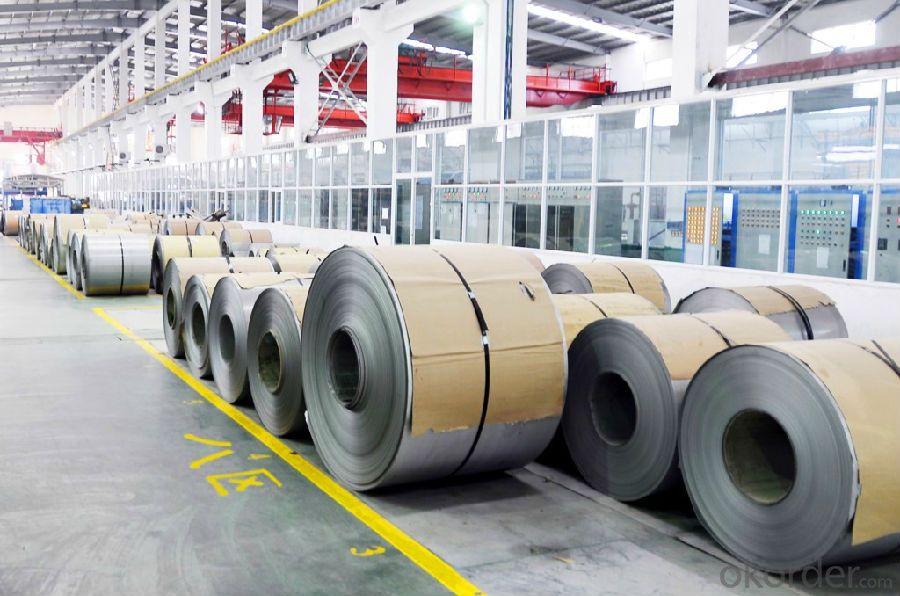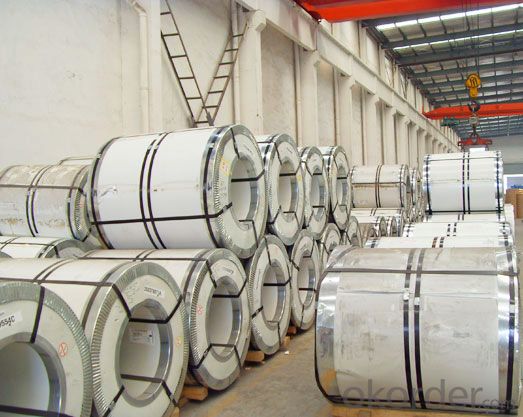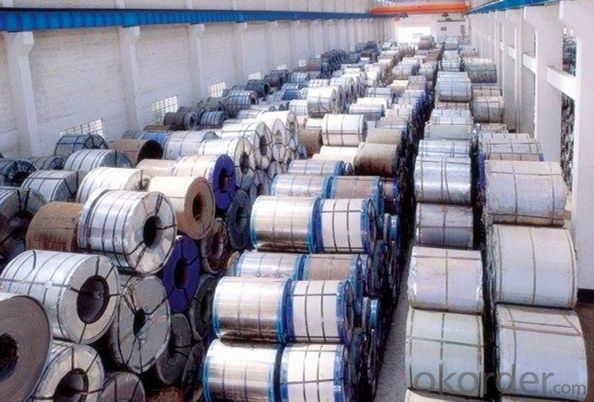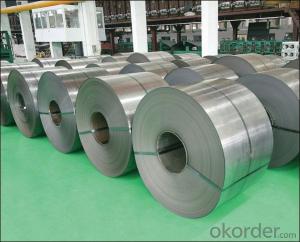Stainless Steel Coil 201 Cold Rolled Hot Rolled Coil Narrow Coil
- Loading Port:
- Lianyungang
- Payment Terms:
- TT OR LC
- Min Order Qty:
- 400 m.t.
- Supply Capability:
- 5000 m.t./month
OKorder Service Pledge
OKorder Financial Service
You Might Also Like
Hot Rolled Stainless Steel Coil 201 Narrow Strip No.1 Finish
Packaging Detail: For customer's requirement
Delivery Detail: 10-30days
201 Hot Rolled Stainless Steel Coil Specifications
THK:2.3/2.5/3.0/4.0mm
Width:485/510/550/610/1010/1240mm
Face:No.1
201 Hot rolled stainless steel Coil Application
Stainless steel is a production which not easy rust,acid resistance and corrosion resistance,so it is widely
used in light industry,heavy industry,daily necessities and the decoration industry.
201 Hot Stainless Steel Coil Chemical Composition(WT%)
(C):≤0.15, (Si):≤0.75, (Mn):5.5~7.50, (Cr):16.0~18.0, (N):≤0.25, (Ni):3.50~5.50, (P):≤0.060, (S):≤0.030
201 Hot Rolled Stainless Steel Coil
Strength Of Extension:100,000 To 180,000 Psi
Yield Strength:50,000 To 150,000 Psi
Elongation :55 To 60%
Modulus Of Elasticity:29,000,000 Psi
Density :.280lbs/Cubic Inch(7.93g/Cm3)



- Q:Are stainless steel strips resistant to scaling?
- Yes, stainless steel strips are generally resistant to scaling. Scaling refers to the formation of oxide layers on the surface of metals when exposed to high temperatures. Stainless steel contains chromium, which forms a passive oxide layer on the surface, providing excellent resistance to scaling. This oxide layer acts as a protective barrier, preventing further oxidation and scaling. However, it is important to note that the resistance to scaling may vary depending on the specific grade and composition of stainless steel being used, as well as the temperature and environment it is exposed to.
- Q:What are the different types of surface finishes for stainless steel strips?
- Stainless steel strips usually undergo different types of surface finishes to improve their appearance, enhance their durability, and increase their resistance to corrosion. Below are some common finishes: 1. Mill Finish: The stainless steel strip is left in its original state after production, resulting in a non-reflective and dull appearance. It may have visible imperfections or marks from manufacturing. 2. No. 1 Finish: Also called HRAP (hot-rolled annealed and pickled), this finish involves annealing the stainless steel strip and pickling it in acid. It creates a smooth, reflective surface with a slightly matte look. No. 1 finish is frequently used in industrial applications where appearance is not a primary concern. 3. No. 2B Finish: Achieved by cold-rolling the stainless steel strip and subsequent annealing and pickling, this finish offers a bright, semi-reflective surface. It strikes a balance between appearance and corrosion resistance, making it suitable for kitchen appliances and architectural elements. 4. No. 4 Finish: Also known as brushed or satin finish, this finish is obtained by mechanically polishing the stainless steel strip with abrasive materials. It results in a smooth, matte appearance with fine parallel lines, giving it a brushed texture. No. 4 finish is commonly used for decorative purposes like furniture, elevator panels, and trims. 5. No. 8 Finish: Referred to as mirror finish, this finish is achieved by polishing the stainless steel strip to create a highly reflective surface. It has a mirror-like appearance with excellent reflectivity. No. 8 finish is often employed in architectural and decorative applications that require a polished, high-end look, such as signage, jewelry, and automotive trims. Apart from these primary surface finishes, there are also specialized finishes available for specific applications, such as embossed, patterned, and colored finishes. These finishes further enhance the aesthetic appeal and functionality of stainless steel strips in various industries.
- Q:Are stainless steel strips suitable for architectural applications?
- Yes, stainless steel strips are suitable for architectural applications. They are highly durable, corrosion-resistant, and have an aesthetically pleasing appearance, making them ideal for various architectural purposes such as cladding, decorative elements, and structural components.
- Q:What are the different grades available in 111 stainless steel strips?
- There are several different grades available in 111 stainless steel strips. The most common grades include 111A, 111B, and 111C. Each grade has its own specific composition and properties that make it suitable for different applications. Grade 111A is a low carbon version of stainless steel, which offers good corrosion resistance and high strength. Grade 111B is a medium carbon stainless steel that provides excellent corrosion resistance and moderate strength. Grade 111C is a high carbon stainless steel, which offers superior strength and hardness, but has slightly lower corrosion resistance compared to the other grades. It is important to consider the specific requirements of your application to determine the most appropriate grade of 111 stainless steel strip to use.
- Q:Can stainless steel strips be used in medical implants?
- Medical implants can utilize stainless steel strips, which are commonly used in the medical industry due to their exceptional corrosion resistance, durability, and biocompatibility. They are frequently employed in the production of medical devices such as surgical instruments and orthopedic implants. To meet the specific requirements of different medical implants, stainless steel strips can be shaped and sized accordingly. The material's ability to resist corrosion ensures its ability to withstand bodily fluids and harsh internal environments, consequently reducing the risk of implant failure or infection. Furthermore, extensive research and documentation have confirmed the biocompatibility of stainless steel. This means that it is well-tolerated by the human body and does not cause any adverse reactions. Thus, stainless steel is a secure and dependable option for medical implants, minimizing the chances of allergic reactions or long-term complications. Nevertheless, it is important to acknowledge that the choice of materials for medical implants ultimately relies on the particular application and the unique needs of each patient. Consulting with medical professionals and adhering to regulatory guidelines is vital in determining the most appropriate material for each individual case.
- Q:What is the creep resistance of stainless steel strips?
- The creep resistance of stainless steel strips refers to their ability to withstand deformation or elongation under sustained high temperatures and constant stress. Stainless steel is known for its excellent creep resistance compared to other materials. This is primarily due to its high chromium content, which forms a protective oxide layer on the surface of the steel, providing enhanced resistance to oxidation and creep deformation. Additionally, stainless steel strips often contain other alloying elements such as nickel, molybdenum, or titanium, which further contribute to their creep resistance. These alloying elements help strengthen the steel and enhance its ability to resist deformation at elevated temperatures, making stainless steel strips a reliable choice for applications where creep resistance is essential, such as in high-temperature environments or under constant stress.
- Q:Can stainless steel strips be used in food processing applications?
- Yes, stainless steel strips can be used in food processing applications. Stainless steel is highly resistant to corrosion, easy to clean, and does not react with food, making it a suitable material for various food processing equipment such as conveyors, mixers, and slicing machines.
- Q:What are the common sizes and dimensions of stainless steel strips?
- The specific application and industry requirements play a role in determining the common sizes and dimensions of stainless steel strips. However, the market does offer standard sizes and dimensions. For instance, one frequently encountered size of stainless steel strips measures 0.025 inches (0.635 mm) in thickness and 1 inch (25.4 mm) in width. This size finds utility in various manufacturing processes such as stamping, forming, and fabrication. Another popular size for stainless steel strips comes in at 0.030 inches (0.762 mm) in thickness and 2 inches (50.8 mm) in width. This size is commonly employed in industries like automotive, construction, and aerospace for applications such as trim molding, gaskets, and seals. Moreover, stainless steel strips are available in a range of thicknesses spanning from as thin as 0.001 inches (0.0254 mm) to as thick as 0.250 inches (6.35 mm). Correspondingly, the widths can range from 0.125 inches (3.175 mm) to 12 inches (304.8 mm) or more. It is essential to note that these dimensions merely represent typical sizes and dimensions. Manufacturers can typically fabricate stainless steel strips in custom sizes and thicknesses to cater to specific project requirements. All in all, the sizes and dimensions of stainless steel strips demonstrate great versatility and can be customized to suit various applications and industries.
- Q:Can stainless steel strips be used for magnetic applications?
- Yes, stainless steel strips can be used for magnetic applications. However, it should be noted that stainless steel is not inherently magnetic and requires specific treatments or alloys to become magnetic.
- Q:Can stainless steel strips be used in high-pressure applications?
- Yes, stainless steel strips can be used in high-pressure applications. Stainless steel is known for its excellent corrosion resistance and high strength, which makes it suitable for use in various industrial applications, including high-pressure environments. Stainless steel strips are often used in the manufacturing of pressure vessels, pipes, valves, and other components that are exposed to high pressures. The material's ability to withstand elevated pressures, combined with its resistance to corrosion and oxidation, makes stainless steel strips a reliable choice for high-pressure applications. Additionally, stainless steel's heat resistance and durability further contribute to its suitability for use in such demanding conditions.
1. Manufacturer Overview |
|
|---|---|
| Location | |
| Year Established | |
| Annual Output Value | |
| Main Markets | |
| Company Certifications | |
2. Manufacturer Certificates |
|
|---|---|
| a) Certification Name | |
| Range | |
| Reference | |
| Validity Period | |
3. Manufacturer Capability |
|
|---|---|
| a)Trade Capacity | |
| Nearest Port | |
| Export Percentage | |
| No.of Employees in Trade Department | |
| Language Spoken: | |
| b)Factory Information | |
| Factory Size: | |
| No. of Production Lines | |
| Contract Manufacturing | |
| Product Price Range | |
Send your message to us
Stainless Steel Coil 201 Cold Rolled Hot Rolled Coil Narrow Coil
- Loading Port:
- Lianyungang
- Payment Terms:
- TT OR LC
- Min Order Qty:
- 400 m.t.
- Supply Capability:
- 5000 m.t./month
OKorder Service Pledge
OKorder Financial Service
Similar products
New products
Hot products
Related keywords






























